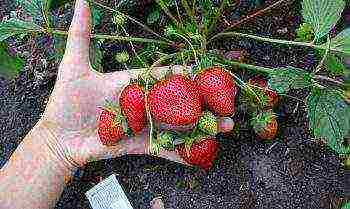Content
- 1 The best varieties of panicled phlox: description and photo
- 2 Blue phlox varieties
- 3 Pink varieties of phlox
- 4 Red phlox varieties
- 5 White varieties of phlox perennials with photos and names
- 6 Orange species and varieties of phlox (with photo)
- 7 Variety of medium flowering, winter hardy
- 8 Perennial varieties of undersized phlox
- 9 Varieties of blue paniculate phlox with large flowers
- 10 Perennial phlox varieties: names and photos
- 11 New early varieties of phlox
- 12 Ground cover varieties of phlox
- 13 The best varieties of tall phlox
- 14 The most beautiful varieties of phlox
- 15 Varieties of annual phlox (with photo)
- 16 Phlox paniculata (Phlox paniculata)
- 17 Spotted phlox (Phlox maculata)
- 18 Split phlox (Phlox divaricata)
- 19 Stolon-bearing phlox (Phlox stolonifera)
- 20 Subulate phlox (Phlox subulata)
- 21 Paniculate phlox - popular varieties with photos
- 22 Ground cover perennial phlox - photo
- 23 Loose phlox - photo
- 24 Stoliferous phlox - photo
- 25 Phlox in landscape design - photo examples
- 25.1 "Albatross"
- 25.2 "Alexander Immer"
- 25.3 "Butonik"
- 25.4 "Bouquet"
- 25.5 "Waltz"
- 25.6 "Gilyay"
- 25.7 "Dove of peace"
- 25.8 "Blue joy"
- 25.9 "Mishenka"
- 25.10 "The Dragon"
- 25.11 Zhukovsky
- 25.12 Sunshine
- 25.13 "Igor Talkov"
- 25.14 "Favorite of Gaganov"
- 25.15 "Old lighthouse"
- 25.16 Preparation of soil, containers and seeds
- 25.17 Timing and landing
- 25.18 Landing in a permanent place
- 25.19 Care after landing
Phlox varieties amaze the imagination with their diversity. It seems that they are created for literally any occasion and occasion. In the catalog phlox varieties on this page, you can find a variety of bouquets, ground cover low-growing species, flowers for decoration of flower beds and flower beds. Descriptions of phlox varieties will help you get the first idea of them, and you can reinforce it by looking at the images. The phlox variety names presented are official. It must be remembered that in everyday life they may have, and other "popular" names, so to navigate it is worth not for variety denominations, but by their appearance and detailed description. Meet the varieties, choose the ones that are suitable for the flower arrangement on your site. All botanical characteristics are given in the information provided. They will help determine if a variety is suitable for certain climatic conditions.
The best varieties of panicled phlox: description and photo
The following are varieties of paniculate phlox, which is extremely common in household plots.
‘Alexander Immer’
Flower with a diameter of 3.0 - 3.7 cm; purple-crimson, even tone; does not fade in the sun. The inflorescence is flat-spherical, small, of medium density. The bush is 45 - 50 cm high, durable. This is the best variety of paniculate phlox of medium flowering period, winter hardy, medium resistant to fungal diseases.
'Albatross'
The description of this variety of paniculate phlox should begin with the fact that its flower is wheel-shaped, with a diameter of 3.5 - 4.0 cm; white, slightly bluish; in hot weather, an asterisk-shaped peephole may appear. The inflorescence is round, of medium density. The bush is 50 - 55 cm high, semi-spreading, medium leafy. Reproduces well. Variety of medium flowering, winter-hardy, resistant to fungal diseases, tolerates adverse weather conditions well.
‘Bouquet’
Flower with a diameter of 3.8 - 4.2 cm; light pink with a light crimson ring; does not fade in the sun. The petals are slightly wavy. The inflorescence is round-conical, very large, dense, beautifully folded. The bush is 60-70 cm high, compact, durable. The stems are pubescent. Leaves are matte, directed downward.Variety of medium flowering, winter-hardy, resistant to fungal diseases.
‘Bud’
Dense pinkish-lilac large non-opening buds in a small dense conical inflorescence; in some years, partial opening of single buds is observed. The bush is 50 - 70 cm high, compact, durable, grows quickly. Reproduces well. Variety of medium flowering, winter hardy.
Check out this variety of paniculata phlox in the photo, which shows all its benefits.
'Waltz'
The flower is wheel-shaped, with a diameter of 3.9 - 4.0 cm; salmon pink with highlighting in the center; fading slightly in the sun. Petals with wavy edges. The tube is purple. The inflorescence is hemispherical, rather dense. The bush is 65 - 70 cm high, compact, powerful, durable, grows quickly. The leaves are dark green. Variety of average flowering period, winter-hardy, moderately resistant to fungal diseases, tolerates unfavorable weather conditions, heat-resistant.
‘Gilyay’
Flower with a diameter of 4.0 - 4.2 cm; light purple with a large radiant white star. The inflorescence is round, large, dense. The bush is 50 - 70 cm high, compact, durable. Variety of medium flowering, winter-hardy, resistant to fungal diseases.
'Dove of peace'
The flower is wheel-shaped, slightly convex, with a diameter of 3.6 - 4.0 cm; pure white. The inflorescence is pyramidal, large, dense. Bush 70 - 90 cm high, erect, strong, well leafy, grows quickly. Reproduces well. Variety of medium early flowering period, winter-hardy, resistant to fungal diseases, tolerates adverse weather conditions well.
Blue phlox varieties
Below are the blue varieties of phlox, which are actually purple in color with different shades. Flowers turn blue under certain lighting conditions. But this gives additional charm to the flower.
‘Blue Otrada’
Flower with a diameter of 3.8 - 4.0 cm; in the daytime, light bluish purple with highlighting in the center and a small dark purple eye; bluish in the evening and indoors. The inflorescence is round-conical, large, of medium density. The bush is 80 - 100 cm high, durable. The stems are pubescent. Variety of medium late flowering, winter hardy, medium resistant to fungal diseases.
'The Dragon'
Flower with a diameter of 3.7 - 4.0 cm; at first dark purple-violet, later gray-silver; in the center is a bright purple-violet star. The inflorescence is round-conical, of medium size and density. The bush is 70 - 90 cm high, strong. Variety of medium flowering, winter-hardy, resistant to fungal diseases.
‘Zhukovsky’
The flower is 3.6 cm in diameter and resembles a hyacinth flower with rounded petals; white with bluish purple shadows. The buds are blue. The inflorescence is round-conical, large, of medium density, openwork. The bush is 80 - 100 cm high, powerful, semi-spreading, grows rapidly. Stems are thin, strong. Reproduces well. Medium flowering variety, resistant to fungal diseases; has great vitality.
"Cinderella"
A wheel-shaped flower with a diameter of 3.0 - 3.8 cm; light lilac, lighter towards the center, with lilac shadows along the edges of the petals and a purple ring. The inflorescence is spherical-conical, branched, large, rather dense. The bush is 50 - 65 cm high, strong, grows quickly. Reproduces well. Variety of medium late flowering, medium resistant to fungal diseases.
‘Igor Talkov’
The flower is wheel-shaped, with a diameter of 4.3 (up to 4.8) cm; dark purple with a whitish center, half of the petal is lighter in tone; does not fade in the sun. The inflorescence is hemispherical, large, dense. The bush is 70 - 75 cm high, compact, durable, grows quickly. Reproduces well. Variety of medium early flowering, winter-hardy, resistant to fungal diseases. Possesses great vitality.
Look at these phlox varieties in the photo, which illustrates all the aesthetic properties of a flower.
Pink varieties of phlox
Pink varieties of phlox are distinguished by their sophistication both in bouquet compositions and in the design of flower beds. The most interesting of them are presented below.
'Childhood'
Wheel-shaped flower, 4.0 cm in diameter; light coral (pink, warm tone with a salmon tint) with a carmine ring. The inflorescence is oval, dense. The bush is 70 - 85 cm high, erect, very durable, grows quickly. Reproduces well. Leaves are not pubescent. Abundant flowering, very long lasting. Variety of medium flowering, winter-hardy, resistant to fungal diseases, tolerates adverse weather conditions well.
Smoky Coral
A wheel-shaped flower with a diameter of 4.5 (up to 5.0) cm; coral pink with a grayish-smoky shade of the edges of the petals. The inflorescence is spherical, compact, large, dense. The bush is 60 - 80 cm high, compact, powerful, durable. Variety of medium flowering, winter-hardy, resistant to fungal diseases, tolerates adverse weather conditions well.
'Pearl'
Flower with a diameter of 3.8 - 4.0 cm; light pink, even tone; does not fade in the sun. The tube is short. The inflorescence is round-conical, rather large, very dense. The bush is 50-60 cm high, compact, semi-spreading, strong. Variety of medium flowering, winter-hardy, resistant to fungal diseases.
‘Zinusha’
Flower with a diameter of 4.5 (up to 4.8) cm; light salmon pink with a carmine ring. The inflorescence is round-conical, very large, dense. The bush is 65 - 70 cm high, compact, durable. Medium flowering variety, resistant to fungal diseases.
‘Isabel’
Flower with a diameter of 4.3 - 4.5 cm; delicate pink shadows over the white field of petals. The inflorescence is round-conical, large, dense. The bush is 60 - 70 cm high, durable, beautiful. Variety of medium flowering, winter-hardy, resistant to fungal diseases.
Look at these phlox varieties in the photo, a description of which can be found under the name of each flower above on the page.
'Johann Sebastian Bach'
A wheel-shaped flower with a diameter of 4.0 - 4.3 cm; red-crimson with gray shading. The inflorescence is round-conical, large, branched, of medium density. The bush is 80 cm high, semi-spreading, strong, grows quickly. Variety of medium flowering, winter-hardy, resistant to fungal diseases.
Red phlox varieties
Red phlox varieties have a rich palette of petal color shades. The most unusual of them are suggested below.
‘Favorite of Gaganov’
The flower is wheel-shaped, with a diameter of 3.5 - 3.7 cm; very bright, brilliant blood-red, even thick tone, velvety; does not fade in the sun, does not deteriorate from rain and dew. The inflorescence is spherical, large, very dense. The bush is 40-50 cm high, compact, durable, grows slowly. Variety of medium late flowering, winter-hardy, resistant to fungal diseases.
‘Manon’
Flower with a diameter of 4.0 - 4.5 cm; pinkish mother-of-pearl with a dull crimson ring; does not fade in the sun, does not deteriorate from rain. Rhombic petals with pointed tips. The inflorescence is round, large, loose. The bush is 70 - 80 cm high, erect, strong, grows well. Reproduces well. Variety of medium flowering, winter hardy, medium resistant to fungal diseases.
‘Maria Fedorovna’
Flower with a diameter of 5.0 - 5.5 cm; deep carmine pink with a salmon tint, with a slight highlight and a small ring slightly darker than the main tone; does not fade in the sun. The petals are slightly wavy. The inflorescence is pyramidal. The bush is up to 100 cm high, erect, grows rapidly. Cracking of the stems is characteristic. Reproduces well. Variety of medium flowering, winter-hardy, resistant to fungal diseases, tolerates adverse weather conditions well.
'Michelle Mercier'
Flower with a diameter of 4.2 - 4.5 cm; purple, very bright, velvety, "burning" in the sun, with a bright red eye and yellow stamens; does not fade in the sun. The inflorescence is round-conical, of medium size and density.The bush is 80 cm high, needs support, grows well. Variety of medium flowering, winter-hardy, resistant to fungal diseases.
‘Moscow Dawns’
Flower with a diameter of 3.7 - 4.0 cm; crimson with a whitish center and a crimson ring; slightly fade in the sun. The inflorescence is round-conical, large, dense. The bush is 70 - 80 cm high, strong, grows quickly. The leaves are dark green. Reproduces well. Variety of medium flowering, winter-hardy, resistant to fungal diseases, tolerates adverse weather conditions well.
Look at the phlox varieties proposed above with the names in the photo, where everything that is said in the description is illustrated:
White varieties of phlox perennials with photos and names
White varieties of phlox are distinguished by a wealth of color combinations on the petals. The pure white phlox is not very interesting. It is much more pleasant to grow flowers with multi-colored blotches on a white field.
"Swan"
A wheel-shaped flower with a diameter of 3.8 cm; milky white with purple dots in the center. The petals overlap strongly. The tube is mauve with stripes. The inflorescence is round-conical, large, dense, beautifully folded. The bush is 80 - 90 cm high, compact, powerful, erect, strong. Reproduces well. Variety of medium late flowering, winter hardy.
‘Lyubasha’
Flower with a diameter of 3.5 cm; bluish-light purple with a white center (in the sun, in mass, pale blue). The inflorescence is spherical-conical, very large, dense. The bush is 60 - 70 cm high, compact, erect, closed, strong, well leafy, grows quickly. Reproduces well.
Variety of medium flowering, winter-hardy, resistant to fungal diseases, tolerates adverse weather conditions well.
‘Margree’
Flower up to 4.2 cm in diameter; original color of the flower: bright purple shadows along the white field of the petals, in the center there is a crimson ring. The inflorescence is round-conical, large, dense. The bush is 80 cm high, compact, strong, grows quickly. The stems are thick. Reproduces well. Variety of medium late flowering, winter-hardy, resistant to fungal diseases.
'Maria'
Flower with a diameter of 4.2 - 4.5 cm; white with a bluish tinge. The petals are slightly wavy. The buds are bluish. The inflorescence is round-conical, large, of medium density. The bush is 80 cm high, strong, grows quickly. Reproduces well.
Variety of medium flowering, winter-hardy, resistant to fungal diseases.
‘Maria Fedorovna’
Flower with a diameter of 3.3 - 3.8 cm; on the white field of the petal in the center there is a wide thick pink stripe; crimson rays in the center of the flower; the color is unstable, reversion is possible - the appearance of monochromatic and shaded flowers. The inflorescence is round-conical, of medium size and density. The bush is 70 - 80 cm high, compact, durable, grows quickly. Reproduces well. Variety of early flowering, winter hardy.
‘Mishenka’
The flower is wheel-shaped, 3.2 - 3.3 cm in diameter; on the white field of the petal in the center there is a wide purple-crimson stripe; does not fade in the sun, but brightens a little as it blooms; the color is not stable, reversion is possible. The inflorescence is pyramidal, of medium density. The bush is up to 100 cm high, durable, grows quickly. Reproduces well. Variety of early flowering, winter-hardy, resistant to fungal diseases.
‘Nadezhda Pavlova’
The flower is wheel-shaped, with a diameter of 3.3 - 3.6 cm; white with a purple-violet ring. The inflorescence is pyramidal, dense. The bush is 80 - 90 cm high, compact, erect, strong, well leafy, grows quickly. Reproduces well. Variety of average flowering period, closer to medium late, winter-hardy, resistant to fungal diseases.
View all these varieties of phlox perennials in the photo, the names of which are suggested above on the page:
Orange species and varieties of phlox (with photo)
Types and varieties of phlox in the modern world of floriculture have the most unusual shades of color in petals.Look further on the orange varieties of phlox, which will successfully decorate absolutely any flower garden.
‘Moscow Fairy Tale’
Flower with a diameter of 4.0 cm; salmon orange with a thin raspberry ring. The reverse side of the petals is light. In hot weather, the flower is star-shaped. The inflorescence is pyramidal, of medium size and density. Bush up to 60 cm high, erect. Medium flowering variety.
‘New Joys’
Wheel-shaped flower, 4.3 cm in diameter; orange red; does not fade in the sun. Petals overlap; the reverse side of the petals is light. The inflorescence is oval, dense, beautifully folded. The bush is 80 cm high, strong, grows quickly. Reproduces well.
Medium flowering variety, winter hardy
'Anniversary'
Flower up to 3.5 cm in diameter; bright fiery; does not fade in the sun. The inflorescence is pyramidal, of medium density. The bush is 80 - 90 cm high, powerful, erect, closed, densely leafy. Anthocyanin-colored stems. Leaves are light green, below are brown veins.
Reproduces well. Medium flowering variety, moderately resistant to fungal diseases.
‘Cecil Henbury’ (‘Cecil Hanbury’)
Flower with a diameter of 3.7 - 4.0 cm; orange-pink with a slight crimson tint, highlighting in the center and a crimson star; does not fade in the sun. The inflorescence is round-conical, large, rather dense. The bush is 80 - 90 cm high, strong, slightly loose, strongly leafy. Variety of medium flowering, winter-hardy, resistant to fungal diseases.
Look at these types and varieties of phlox in the photo, which illustrates the richness of shades:
Perennial varieties of undersized phlox
Perennial varieties of low-growing phlox look great in flower beds and embossed flower beds. The following are varieties of low-growing phlox with different types of petal color.
‘Maria Nagibina’
Flower with a diameter of 3.0 - 3.5 cm; pale pink with a lilac shade, with a wide carmine ring. The petals curl upward to form a star-shaped flower. The inflorescence is pyramidal, dense. The bush is 20 - 25 cm high, erect. The leaves are concave, directed downward. Medium flowering variety, resistant to fungal diseases.
'Youth'
Flower with a diameter of 4.0 cm; light pink, pale pink as it blooms. The inflorescence is round-conical, rather large, dense. The bush is 20 - 25 (up to 30) cm high, compact, durable, well leafy. Variety of medium flowering, winter-hardy, resistant to fungal diseases.
‘People’s’
Flower with a diameter of 3.5 - 4.0 cm; light pink with a carmine ring. The inflorescence is round, large, dense. The bush is up to 40 cm high, compact, durable, grows quickly. Abundant flowering, long lasting. Reproduces well. Variety of medium flowering, winter hardy.
‘Nakhodka’
Flower with a diameter of 3.6 - 4.3 cm; warm pink with a salmon tint, with a white eye; does not fade in the sun, in hot weather a thin raspberry ring may appear. The inflorescence is round-conical, large, dense. The bush is 40 cm high, erect, strong. Variety of medium flowering, winter-hardy, resistant to fungal diseases, tolerates adverse weather conditions well.
'Heaven'
Flower with a diameter of 3.8 - 4.0 cm; white with a slight bluish tint and lilac short rays from the center. The buds are blue. The inflorescence is round-conical, large, dense. The bush is 20 - 25 cm high, durable, beautiful, grows quickly. Abundant flowering, long lasting. Reproduces well. Variety of medium early flowering, winter-hardy, resistant to fungal diseases.
‘Stranger’
Flower with a diameter of 3.7 cm; uneven purple-pink with a small white eye. The inflorescence is round, medium-sized, dense. The bush is 30 cm high, compact. The stems are strong. Variety of medium flowering, winter hardy.
‘New’
Flower with a diameter of 4.0 - 4.3 cm; white with cyan shadows and magenta dots in the center. The buds are blue, bright. Inflorescences are round, dense.
The bush is 20 - 25 cm high, compact, erect, strong, well leafy, grows quickly. Long flowering. Reproduces well. Variety of medium late flowering, winter-hardy, resistant to fungal diseases, tolerates adverse weather conditions well.
Varieties of blue paniculate phlox with large flowers
Blue varieties of phlox wonderfully set off the splendor of roses and the simplicity of marigolds. Look at the large-flowered varieties of paniculate phlox later on the page for short descriptions, names, and other relevant information.
‘Night’
The flower is wheel-shaped, with a diameter of 3.5 - 3.7 cm; in the afternoon lilac, even tone; in the evening, in cloudy weather and in a blue-blue room; a white eye may appear. The petals are slightly wavy. The inflorescence is round-conical, medium-sized, dense. The bush is 65 - 70 cm high, compact, durable, grows quickly. Variety of medium flowering, winter hardy, medium resistant to fungal diseases.
‘Olenka’
Wheel-shaped flower, up to 4.0 cm in diameter; pale pink with a large white center and a bright carmine ring; does not fade in the sun. The inflorescence is spherical-conical, large, dense. The bush is 60 - 70 cm high, erect, strong, well leafy, grows quickly. Reproduces well. Variety of medium flowering, winter hardy, medium resistant to fungal diseases, tolerates adverse weather conditions well.
‘Autumn Bouquet’
The flower is wheel-shaped, with a diameter of 3.0 - 3.5 (up to 3.8) cm; pale lilac pink; whitens as it blooms. At the beginning of flowering, the edges of the petals are bent upward. The tube is deep lilac. The inflorescence is round, medium-sized, dense. Bush 60-70 cm high, compact, erect, strong, well leafy. The leaves are dark green. Long flowering. Variety of medium late flowering, winter hardy, medium resistant to fungal diseases, but tolerates adverse weather conditions well.
'Sandro Botticelli'.
Flower with a diameter of 4.5 (up to 5.0) cm; in the afternoon lilac, even tone; bluish in the evening; slightly fade in the sun. The inflorescence is round-conical, rather large, of medium density. The bush is 70 - 75 cm high, strong, grows quickly. Variety of medium flowering, winter-hardy, resistant to fungal diseases.
'Blue ocean'
The flower is wheel-shaped, with a diameter of 3.8 - 4.0 cm; purple-lilac in the afternoon, blue in the evening; slightly fade in the sun. The inflorescence is round, medium-sized, dense. The bush is 60 - 65 cm high, strong, grows quickly. Variety of medium flowering, winter-hardy, resistant to fungal diseases.
'Lilac Caprice'
Flower with a diameter of 3.5 - 3.6 cm; pale lilac with darker shadows and a lilac ring. The inflorescence is rounded-conical, of medium size and density. The bush is 60 cm high, loose, grows well. Abundant flowering. Medium early flowering variety.
‘Lilac Miracle’
Wheel-shaped flower, 5.0 cm in diameter; in the afternoon lilac, even tone; bluish in the evening. The inflorescence is round-conical, large, of medium density. The bush is 80 - 90 cm high, powerful, durable, grows quickly. Variety of medium flowering, winter hardy.
Perennial phlox varieties: names and photos
Perennial phlox varieties are suitable for growing in the country and in the garden.
The following are varieties of perennial phlox with photos and names, among them you can find a suitable type for your flower garden.
‘Pink Tale’
Flower with a diameter of 4.5 - 4.7 cm; light pink with a bright crimson eye. The inflorescence is round, rather large, of medium density. The bush is 70 - 90 cm high, compact, grows slowly. Medium flowering variety, resistant to fungal diseases.
'Blush Girl'
Flower with a diameter of 3.3 - 3.5 cm; white with pink shadows, one half of the petal (in hot weather, the "blush" disappears). The buds are pink. The inflorescence is round-conical, medium-sized, dense. The bush is 100 cm high, loose.The variety has an average flowering period, freezes under severe winters.
‘Pink Rayonant’
Flower up to 4.0 cm in diameter; pink with a light carmine shade and a large blurred carmine star in the center. The inflorescence is round-conical, of medium size and density. The bush is 70 cm high, strong, grows rather slowly. Variety of medium flowering, winter hardy.
'Rosy'
The flower is wheel-shaped, with a diameter of 3.8 - 4.0 cm; white with a blurred carmine-red eye. The inflorescence is pyramidal, lush, of medium density. The bush is 70 - 80 cm high, compact, powerful, grows quickly. Reproduces well. Variety of medium early flowering period, winter-hardy, resistant to fungal diseases, tolerates adverse weather conditions well.
'Russian beauty'
The flower is wheel-shaped, with a diameter of 3.7 - 3.8 cm; deep pink with a raspberry tint, in the center there is a slight highlight; half of the petal is lighter in tone; fading to light pink in the sun. The inflorescence is round-conical, medium-sized, rather dense. The bush is 70 - 80 cm high, strong, grows quickly. The stems are dark. Variety of medium flowering, winter-hardy, resistant to fungal diseases.
‘Svyatogor’
Flower with a diameter of 4.5 - 4.7 cm; bright red with a cinnabar tint, of an even pure tone; does not fade in the sun. The inflorescence is round, of medium density. The bush is 45 - 50 cm high, compact, durable. Variety of medium early flowering period, winter hardy, medium resistant to fungal diseases.
'Shy girl'
Flower with a diameter of 3.8 - 4.0 cm; soft pink, warm tone, uniform color (apple-tree color). The inflorescence is spherical-conical, medium-sized, dense. The bush is 60 -70 cm high, strong, grows well. Medium late flowering variety.
‘Old man’
Flower with a diameter of 3.6 - 3.8 cm; purple violet; as it blooms, the original silvery shading appears and gradually intensifies, the flower appears silvery, the center of the flower remains purple-violet. The inflorescence is round-conical, of medium size and density. The bush is 70 - 90 cm high, compact, durable, grows quickly. Variety of medium flowering, winter-hardy, resistant to fungal diseases.
Look at these varieties of perennial phlox in the photo, which shows the appearance of each flower:
New early varieties of phlox
New varieties of phlox are always in high demand. We suggest paying attention to the following early varieties of phlox, which will delight the eye with flowering in any climatic conditions.
'Sleeping Beauty'
Flower with a diameter of 3.5 - 3.7 cm; white with a barely noticeable lilac-bluish shadow (blue). The tube is purple. The inflorescence is spherical, flat, large. The bush is 60 - 70 cm high, durable. Variety of medium flowering, winter hardy, medium resistant to fungal diseases.
'Gangway'
Flower with a diameter of 3.8 - 4.0 cm; purple-crimson, even tone; in cool weather, a white center may appear; does not fade in the sun. The inflorescence is pyramidal, of medium size and density. The bush is 90 - 110 cm high, erect, well leafy. Variety of medium flowering, winter-hardy, resistant to fungal diseases, tolerates adverse weather conditions well.
'Taras Shevchenko'
Wheel-shaped flower, 3.7 cm in diameter; deep coral pink with an orange tint and slight lightening towards the center; does not fade in the sun. The inflorescence is round-conical, large, dense. The bush is 80 cm high, powerful, durable. Medium flowering variety.
'Fog'
A wheel-shaped flower with a diameter of 3.0 - 3.5 cm; pale bluish lilac with a light crimson ring; morning and evening bluish. The petals are slightly wavy.
The inflorescence is round-conical, large, dense. The bush is 65 - 80 cm high, semi-spreading, strong, growing rapidly. The leaves are elongated. Reproduces well. Variety of medium early flowering, winter-hardy, resistant to fungal diseases.
'Apple Blossom'
A wheel-shaped flower with a diameter of 4.5 (up to 4.8) cm; soft pink, warm tone with a large white center; does not fade in the sun.
The inflorescence is umbrella-shaped, large, dense. The bush is 50-60 cm high, compact, durable. Reproduces well. Variety of medium flowering, winter-hardy, resistant to fungal diseases.
‘Junnat’
Flower up to 5.0 cm in diameter; deep pink with a carmine ring; does not fade in the sun. The inflorescence is round-conical, large, dense. The bush is up to 80 cm high, compact, durable, grows slowly. Variety of medium flowering, winter-hardy, resistant to fungal diseases.
Ground cover varieties of phlox
‘Yaroslavna’
This ground cover variety of phlox has a flower with a diameter of 3.7 cm; light purple (almost white) with transitions to white, with a cherry ring; in the evening and in cloudy weather it turns blue. Corrugated petals.
The inflorescence is spherical-conical, very dense. The bush is 50 - 60 cm high, compact, durable. Reproduces well. Variety of medium flowering, winter hardy, not resistant to fungal diseases.
'Dear friend'
Flower with a diameter of 4.3 cm; pink, warm tone with a pink-purple blurred center. The inflorescence is round-conical, large, dense. The bush is 65 cm high, compact, durable. Medium flowering variety.
The best varieties of tall phlox
The best varieties of phlox are those that can be planted along the fence and forget about the existence of the hedge. The varieties of tall phlox can be viewed on this page further: the description will make it possible to understand how they are suitable for the site.
‘Altair’
Flower with a diameter of 3.0 - 3.5 cm; at the beginning of the dissolution on a lilac-lilac background, a thick beige haze (beige-pearl effect); in the center there is a large white radiant star with a lilac halo, occupying 2/3 of the radius of the flower corolla; as it blooms, the star becomes lilac-lilac, and the edges of the corolla are silvery (the zone of the star and the edges of the petals reversely change color); in the morning the star has a cold lavender hue, in the center there is a thin ring of the same shade as the halo of the star. The inflorescence is round-conical, dense. The bush is 80 - 100 cm high, compact, erect, grows well. Medium late flowering variety.
'Ariadne'
Flower with a diameter of 2.4 cm; pale pink with a thin white ring; at the beginning of flowering, the center is slightly more intense in color. The reverse side of the petals is white-pink. The inflorescence is round-conical with protrusions, large, dense. The bush is 100 cm high, erect. Leaves are lanceolate, concave. Medium flowering variety.
‘Berendey’
Flower with a diameter of 4.2 - 4.5 cm; lilac-purple medium tone (evenly lilac); as it blooms, a silvery-gray haze appears and intensifies. The inflorescence is round, rather dense. The bush is 70 - 80 cm high, powerful, semi-spreading, durable, grows quickly. Medium flowering variety.
'Knapweed'
Flower with a diameter of 3.5 cm; lilac lilac; the color is more saturated in the center, gradually brightens towards the edges of the petals to a white thin border. Basic tone buds. The tube is purple. The inflorescence is oval-conical, large, of medium density. The bush is 90 cm high, erect. Medium flowering variety.
‘Vasilisa’
Flower with a diameter of 3.5 cm; pink crimson; the color is more saturated in the center, gradually brightens towards the edges of the petals to a white thin border. Basic tone buds. The tube is dark pink. The inflorescence is oval-conical, large, of medium density. The bush is 90 cm high, erect. Medium flowering variety.
'Venice'
Flower with a diameter of 4.4 - 5.0 (5.6) cm; In the afternoon, ash-deep pink with a bright crimson-pink star in the center; morning and evening silvery. The petals are slightly elongated, slightly separated from each other. The inflorescence is inclined, rounded-conical, of medium size and density. The leaves are dark green, elongated. The bush is 80 - 90 cm high, semi-spreading, grows slowly.
'Dessert'
A wheel-shaped flower with a diameter of 3.0 - 3.5 cm; white with delicate pinkish-lilac shadows and lilac-pink ringlet; brightens to white in hot weather. The petals overlap. The inflorescence is large, dense. The bush is 70 - 80 cm high, compact, durable, grows quickly. Stems with short internodes. Medium flowering variety.
‘Red’
Wheel-shaped flower, 3.5 cm in diameter; pure pink with a bright carmine wide ring. The inflorescence is conical with projections, large, dense. The bush is 135 cm high, erect, grows rapidly. Late flowering variety.
The most beautiful varieties of phlox
Well, the time has come to present the most beautiful varieties of phlox for breeding in a personal plot. When starting to study beautiful varieties of phlox, it is important to understand that breeding them will require a fairly large space. So don't be greedy. Buy only the very best views.
‘Margarita’
Flower with a diameter of 4.3 cm; bright, crimson red with a darker eye. The inflorescence is round-conical, dense. The bush is 75 cm high, compact, durable. Medium flowering variety.
'Mulatto'
Flower with a diameter of 3.5 - 3.6 cm; lilac purple with a white center; as it blooms, a silvery haze appears, the white center gradually acquires the color of the main tone. The inflorescence is round-conical, of medium size and density. The bush is 90 cm high and grows well. Medium flowering variety.
'Forget-me-not'
A flower with a diameter of 4.3 cm, resembles a forget-me-not flower; lilac in the afternoon, blue in the evening, bright. The inflorescence is hemispherical. The bush is 70 cm high, compact, durable. Medium flowering variety.
‘Perun’
Flower with a diameter of 4.0 cm; purple crimson, bright; as it blooms, a silvery haze appears, the center of the flower remains crimson. The inflorescence is of medium size and density. The bush is 80 - 85 cm high, grows slowly. Medium flowering variety.
‘Bird Sirin’
A star-shaped flower with a diameter of 2.0 - 2.4 cm; in the afternoon lilac with a whitish asterisk; turns blue in the evening and in cloudy weather. The inflorescence is large, branched. The bush is 70 - 80 cm high, strong, grows quickly. The stems are dark. A medium-flowering variety with great vitality.
‘Ultar’
The flower initially has a cup-shaped shape, as it blooms, the cup-shaped shape may not persist in all flowers, with a diameter of 4.0 - 4.5 cm; dark purple crimson with a darker center. The reverse side of the petals is light. The inflorescence is round-conical, large, dense. The bush is 100 - 120 cm high, powerful. Medium late flowering variety.
‘Faina Ranevskaya’
Flower with a diameter of 3.8 cm; matte red. The inflorescence is pyramidal, large, rather dense. The bush is 100 cm high, powerful, erect, durable, grows quickly. The stems are thick. The edges of the leaves are down. Long flowering. Medium flowering variety, resistant to fungal diseases.
‘Aida’
Flower with a diameter of 3.5 - 4.0 cm; deep purple with a carmine eye; does not fade in the sun. The inflorescence is spherical, medium in size, rather dense. The bush is 60 cm high, compact, erect. Medium flowering variety, moderately resistant to fungal diseases.
‘Balmoral’
A flower with a diameter of 3.7 - 4.2 cm, light pink with a dim crimson ring; deteriorates from humidity and temperature changes. The inflorescence is round-conical, large, of medium density. The bush is 70 - 90 cm high, erect, strong. Long flowering. Variety of medium flowering, winter-hardy, resistant to fungal diseases, does not tolerate adverse weather conditions.
'Blue Bed' (‘Blue Bird’)
Flower with a diameter of 4.0 - 4.3 cm; white with lilac-blue shadows and a purple ring. The buds are lilac-blue. The inflorescence is round-conical, of medium size and density. Bush 80 cm high, strong, well leafy, grows quickly. Variety of medium flowering, winter-hardy, resistant to fungal diseases.
‘Blue Paradise’
Flower with a diameter of 3.7 - 4.2 cm; in the afternoon lilac with a slight highlight in the center and a dark purple ring; in the morning, in the evening and in cloudy weather, blue-blue with a dark blue-violet ring. The petals are slightly wavy. The inflorescence is round-conical, of medium size and density. The bush is 100 - 120 cm high, semi-spreading, durable, grows quickly. The stems are dark. Variety 'of medium flowering, winter-hardy, resistant to fungal diseases.
‘West’ (‘West’)
Flower with a diameter of 1.5 - 2.0 cm; bright, dark crimson; does not fade in the sun. The inflorescence is round-conical, large, of medium density. The bush is up to 150 cm high, powerful, grows quickly. Long flowering. Variety of medium late flowering, winter-hardy, resistant to fungal diseases.
‘Viking’
Flower with a diameter of 3.7 - 4.0 cm; pink with a slight highlight in the center and a ring darker than the main tone; does not fade in the sun. The petals are slightly wavy.
The inflorescence is round-conical, very dense. The bush is up to 90 cm high, compact, dense, erect, strong, well leafy, grows quickly. The stems are dark. The leaves are elongated. Reproduces well. Variety of medium late flowering, winter-hardy, resistant to fungal diseases, tolerates adverse weather conditions well.
‘Württembergia’
Flower with a diameter of 3.8 - 4.0 cm; raspberry pink; does not fade in the sun. The inflorescence is round, medium-sized, dense. The bush is 70 cm high, compact, durable. Variety of medium flowering, winter hardy.
'Dorffroyde' (‘Dorffreude’)
Flower with a diameter of 3.5 cm; pink lilac with a pale carmine ring; turns pale as it blooms. The inflorescence is round-conical, loose. The bush is 100 cm high, erect. Variety of medium flowering, winter-hardy, resistant to fungal diseases.
'Europe'
The flower is wheel-shaped, with a diameter of 3.5 - 3.8 cm; white with a carmine ring. The inflorescence is pyramidal, large, dense, beautifully folded. The bush is 80 cm high, compact, powerful, dense, erect, strong, well leafy, beautiful, grows quickly. Reproduces well. Variety of medium late flowering, winter-hardy, resistant to fungal diseases, tolerates adverse weather conditions well.
‘Jules Sando’ (‘Jules Sandeau’)
Flower with a diameter of 4.0 - 4.5 cm; raspberry pink with a thin ringlet slightly darker than the main tone. The reverse side of the petals is light.
The petals are slightly wavy, the edges are slightly raised. The inflorescence is round, medium-sized, dense. The bush is 50 - 60 cm high, compact, durable. Stems with a brownish tint. The leaves are dark green, wide, shiny. Variety of medium flowering, winter-hardy, resistant to fungal diseases.
Varieties of annual phlox (with photo)
Annual phlox varieties can often be bred in perennial crops. This is indicated by the parameter of winter hardiness. If it is high, then the bushes will successfully overwinter under the snow cover.
‘Zilberlax’ (‘Silberlachs’)
Flower with a diameter of 4.0 cm; silver-pink-lilac with characteristic shading, dim highlighting towards the center, with a ringlet slightly darker than the main tone. The inflorescence is round-conical, large, dense. The bush is 90 - 100 cm high, compact, erect, strong, well leafy, beautiful, grows slowly. The stems are dark. Variety of medium flowering, winter hardy, medium resistant to fungal diseases.
‘Madame Dr. Charcot’ (‘Madame Doctor Charcot’)
Wheel-shaped flower, 3.5 cm in diameter; pale pink, lightens to whitish pink as it blooms. The petals are slightly wavy. The inflorescence is round, large, dense. The bush is 70 cm high, compact, erect, strong. Reproduces well. Medium flowering variety, resistant to fungal diseases.
‘Miss Pepper’ (‘Miss Pepper’)
The flower is wheel-shaped, with a diameter of 2.0 - 2.3 cm; light pink with a bright crimson ring. The petals are rounded. The inflorescence is round-conical, branched, very large, dense.The bush is 70 - 90 cm high, compact, erect, strong, grows quickly. Reproduces well. Long flowering. Variety of medium late flowering, resistant to fungal diseases.
‘Miss Eli’ (‘Miss Elie’)
A star-shaped flower with a diameter of 2.5 - 3.0 cm; light pink with a large bright blurred carmine center. The petals are slightly wavy, separated from one another. The inflorescence is round-conical, rather large, dense, openwork. The bush is 70 - 90 cm high, powerful. Variety of medium late flowering, resistant to fungal diseases.
‘Mrs. Ethel Pritchard’ (‘Mrs. Ethel Pritchard’)
Flower up to 3.2 cm in diameter; light purple (lavender) with a grayish tint. The inflorescence is pyramidal, large, branched, dense. The bush is 80 - 100 cm high, erect, strong. The stems are thin. Variety of medium late flowering, winter-hardy, resistant to fungal diseases, tolerates adverse weather conditions well.
‘Ost’ (‘Ost’)
Flower with a diameter of 1.5 - 2.0 cm; bright, crimson with a darker ring; does not fade in the sun. The inflorescence is round-conical, large, of medium density. The bush is 70-80 cm high, strong, grows quickly. The stems are dark. Long flowering. Variety of medium late flowering, winter-hardy, resistant to fungal diseases.
'Panama' (‘Panama’)
Flower with a diameter of 3.0 - 3.5 cm; pure white with a light green tube. The inflorescence is pyramidal, of medium size and density. The bush is 70 - 80 cm high, spreading. Stems are thin, strong. Reproduces well. Variety of medium flowering, winter hardy, medium resistant to fungal diseases, tolerates adverse weather conditions well.
"Rayonant" (Rayonnant)
Wheel-shaped flower, 4.0 cm in diameter; grayish lilac with a gradual darkening towards the center and a purple-crimson asterisk. There is a notch along the edge of the petal. The inflorescence is broad-pyramidal, dense. The bush is 65 - 80 cm high, compact, erect. Stems with short internodes. Leaves are dark green, dense. Medium flowering variety, resistant to fungal diseases.
‘Salmon Glow’ (‘Salmon Glow’)
The flower is wheel-shaped, with a diameter of 4.5 - 5.0 cm; salmon pink with a white center; slightly fade in the sun. The reverse side of the petal is almost white. The inflorescence is round-conical, large, dense. The bush is 80 - 90 cm high, erect, dense, grows well. Medium flowering variety, resistant to fungal diseases.
‘Sweet William’(‘ Sweet William ’)
Flower with a diameter of 1.5 - 2.0 cm; lilac-purple with a small white ring. The inflorescence is large, branched. Bush up to 100 cm high, erect, strong. The leaves are dark green. Long flowering. Medium flowering variety.
Look at the varieties of annual phlox in the photo, which shows a variety of plants.
‘Starfire’ (‘Starfire’)
Flower with a diameter of 3.5 - 3.7 cm; dark cinnabar red, very bright; does not fade in the sun. The inflorescence is round-conical, medium-sized, dense. The bush is 80 - 90 cm high, erect, strong. The stems are dark. Variety of medium late flowering, winter hardy.
‘Fliederball’ (‘Fliederball’)
Flower with a diameter of 3.5 - 4.0 cm; lilac, even tone; turns blue in the evening and in cloudy weather; slightly fade in the sun. The inflorescence is round-conical, large, very dense. The bush is 70 cm high, compact, strong, grows well. Variety of medium flowering, winter-hardy, resistant to fungal diseases.
‘Fujiyama’ (‘Fujiyama’)
Flower with a diameter of 2.5 - 3.2 cm; pure white with yellow stamens. The petals are separated from each other. The inflorescence is pyramidal, large, dense. The bush is up to 140 cm high, compact, durable. Late flowering variety, winter-hardy.
‘Hochgesang’ (‘Hochgesang’)
Flower with a diameter of 3.2 - 3.5 cm; pure white. The inflorescence is fractional-conical, branched, large, loose. Bush up to 180 cm high, lumbering; because of the large inflorescences and high height, the stems fall, they need support.Late flowering variety, winter-hardy, resistant to fungal diseases.
‘Sternchimmel’ (‘Sternhimmel’)
Wheel-shaped flower, 3.7 cm in diameter; light lilac with darker strokes and shadows, with a light lilac ring. The inflorescence is round, medium in size, rather dense. The bush is 70 - 90 cm high, compact, erect, strong. Reproduces well. Variety of medium flowering, winter-hardy, resistant to fungal diseases.
‘Elizabeth Arden’ (‘Elisabeth Arden’)
A wheel-shaped flower with a diameter of 4.0 - 4.3 cm; pink with highlighting in the center; does not fade in the sun. The inflorescence is round-conical, of medium size and density. Shrub up to 95 cm high. Variety of average flowering period, moderately resistant to fungal diseases.
‘Grenadine Dream’ (‘Grenadine Dream’)
Wheel-shaped flower, 3.0 cm in diameter; red crimson; does not fade in the sun. The inflorescence is round-conical, medium-sized, rather dense. The bush is 50 - 60 cm high, compact, durable. Medium flowering variety, resistant to fungal diseases, tolerates adverse weather conditions well.
‘Jade’ (‘Jade’)
Flower with a diameter of 1.5 - 2.0 cm; white with greenish (olive yellow) tips. The petals overlap. The inflorescence is dense. The bush is 60 - 70 cm high, compact, erect. Variety of medium late flowering, resistant to fungal diseases.
‘Magic Blue’ (‘Magic Blue’)
Flower with a diameter of 3.5 - 3.8 cm; lilac-lilac with gray-silver dusting; the light center changes as it blooms. The inflorescence is oval-conical, medium density. The bush is 65 - 80 cm high, quite durable. Long flowering. Variety of medium late flowering, resistant to fungal diseases.
"Neon Flair"
Flower with a diameter of 3.0 - 3.2 cm; original painting; white with a purple-crimson center and shadows around the edges of the petals; as it blooms, the purple-crimson center increases. The buds are purple. The inflorescence is round-conical, of medium size and density. The bush is 55 - 60 cm high, strong, grows quickly. Medium flowering variety.
'Halo' (‘Aureole’)
Flower with a diameter of 1.5 - 2.0 cm; bright magenta with olive yellow edges. The petals overlap. The inflorescence is of medium size and density. The bush is 50 cm high, erect, strong. Variety of medium late flowering, resistant to fungal diseases.
'Peppermint Twist’(‘ Peppermint Twist ’)
A wheel-shaped flower with a diameter of 3.0 - 4.0 cm; there is a wide bright pink stripe on the white field of the petal; unstable coloration, reversion is possible. The inflorescence is round-conical, large, dense. The bush is 50 - 70 cm high, erect, strong. Variety of medium early flowering, resistant to fungal diseases.
‘Red Caribbian’ (‘Red Caribbean’)
Flower with a diameter of 3.0 - 3.5 cm; at the beginning it is light crimson with a bright deep red eye, then a silvery shading appears, which intensifies as it blooms - the flower becomes silvery with a bright deep red eye. The edges of the petals are raised. The inflorescence is round-conical, small, of medium density. The bush is 50 - 65 cm high, compact, durable, grows quickly. Medium flowering variety.
‘Spinners’ (‘Spinners’)
Flower with a diameter of 3.5 - 4.0 cm; on the white field of the petal there is a wide bright dense pink stripe; unstable coloration, reversion is possible. The inflorescence is round-conical, of medium size and density. The bush is 60 - 70 cm high, erect, strong. Medium flowering variety.
‘Strawberry Dakyury’ (‘Strawberry Daiquiri’)
Flower with a diameter of 2.5 - 2.8 cm; bright, intense red. The inflorescence is round-conical, compact, dense. The petals overlap. The bush is 40 - 50 cm high, compact, durable, grows quickly. Stems with short internodes. The edges of the leaves are down. Medium flowering variety, resistant to fungal diseases.
‘Twister’ (‘Twister’)
Flower with a diameter of 3.5 - 4.0 cm; on the white field of the petal there is a narrow, feather-like red-pink stripe; unstable coloration, reversion is possible. The inflorescence is round-conical, of medium size and density. The bush is 60 - 70 cm high, compact. Medium flowering variety, resistant to fungal diseases.
'Tequila Sunrise' (‘Tequila Sunrise’)
Flower with a diameter of 3.0 - 3.5 cm; bright, orange-red. The inflorescence is round-conical, large, dense. The bush is 55 - 65 cm high, compact, erect, grows quickly.The stems are dark. Medium flowering variety.
'Tiara' (‘Tiara’)
A flower with a diameter of 2.0 - 2.4 cm, does not fully open; white, greenish towards the center and in the fauces. The petals overlap strongly. The inflorescence is round-conical, small, overly dense. The bush is 65 - 80 cm high, compact. Medium flowering variety, resistant to fungal diseases.
‘Sherbet Cocktail’ (‘Sherbet Cocktail’)
Flower with a diameter of 1.5 - 2.0 cm; pale pinkish lilac, delicate tone with olive yellow edges. The buds are yellowish green. The inflorescence is medium in size, dense. The bush is 70 - 100 cm high, strong. Variety of medium late flowering, resistant to fungal diseases.
‘Edene Smile’ (‘Eden’s Smile’)
Flower with a diameter of 3.0 - 3.5 cm; lilac pink with a silvery haze; the light center later changes to dark lilac. The inflorescence is round-conical, branched, rather dense. The bush is 70 - 80 cm high, compact, durable. Variety of medium late flowering, resistant to fungal diseases.
Save for yourself our selection of the most common species and varieties of phlox in the culture. We are sure that you will certainly find something for your garden in it!
Phlox are delightful flowers that amaze with a variety of shapes, sizes and shades. Among them there are bush and ground cover species, and spring and summer flowering. You can choose a variety with white or variegated flowers. Whichever species or cultivar you choose, you can be sure of one thing - phloxes will not disappoint you.
Phlox paniculata (Phlox paniculata)
This is perhaps the most common type of phlox that can be found in almost every flower garden. It blooms all summer until early autumn, strikes with color and fills the garden with a pleasant sweet aroma.
Panicled phloxes are indispensable for bowlders and curbs. They can be safely planted in the most conspicuous place without worrying that the flowers will fade due to the heat and the scorching sun. On the other hand, they bloom no less luxuriantly with light shading.
It is important to consider that for good growth, paniculate phloxes need good air circulation, so you should not plant them close to buildings. These plants should never be mulched in the summer.
Wherever you place the bushes of this phlox, be sure that bees and butterflies will constantly circle around.
This is a bush type of phlox, which belongs to the tall group. Paniculate phlox grow up to 1.2 m in height, depending on the variety, prefer moderate watering and well-drained soil.
Amethyst
Spectacular phlox of medium height with fragrant bluish-lilac inflorescences.
| Color of petals | Bush height (cm) | Bush width (cm) | Flowering time |
| Bluish purple | 80-90 | 30-60 | July August |
Blue Paradise
Blue Paradise is a paniculate phlox with charming bluish lavender flowers that exude a pleasant light aroma. This cultivar is considered to be tall.
| Color of petals | Bush height (cm) | Bush width (cm) | Flowering time |
|
Bluish lavender |
90-120 | 30-60 | July August |
Bright Eyes
A charming medium-sized phlox with a strong aroma. It is not afraid of fungal diseases and is unlikely to give you any trouble in care.
| Color of petals | Bush height (cm) | Bush width (cm) | Flowering time |
| Pale pink | 45-60 | 30-60 | July August |
David
Luxurious snow-white phlox David received a prestigious award from British florists. This stately handsome man grows well both in the sun and in partial shade, practically does not get sick.
| Color of petals | Bush height (cm) | Bush width (cm) | Flowering time |
| Snow white | 90-120 | 30-60 | July August |
Delilah
A short plant with pinkish purple flowers. Phlox varieties Delilah are generally not capricious and resistant to various kinds of diseases, but sometimes they can be prone to spotting.
| Color of petals | Bush height (cm) | Bush width (cm) | Flowering time |
| Magenta | 50-60 | 30-50 | July-September |
Candy Twist
Candy Twist is a paniculata phlox with a mischievous striped color that resembles candy. This phlox is very aromatic, does not fade in the sun, and is resistant to diseases.
| Color of petals | Bush height (cm) | Bush width (cm) | Flowering time |
| White and pink stripes | 45-60 | 60-70 | July-September |
Sandro Botticelli
A delightful variety of phlox, bred by Yuri Reprev, is deservedly named after the great Italian painter. Sandro Botticelli admires the delicate lilac-pink color. You might think that he came straight from the artist's canvas.
| Color of petals | Bush height (cm) | Bush width (cm) | Flowering time |
|
Mauve |
70-75 | 60-70 | July August |
Spotted phlox (Phlox maculata)
Spotted phlox is also often called meadow or pyramidal. It is a very close relative of the phlox paniculata. It is possible to distinguish the spotted phlox from its more popular "brother" by two features: small burgundy spots on the stem and the pyramidal shape of the inflorescences.
Like other phloxes, this species likes moist, fertile soil and well-lit or partially shaded areas. It should be borne in mind that, unlike paniculate phloxes, spotted ones often fall ill with powdery mildew, are prone to nematodes and spots.
Phlox spotted in beauty is not inferior to phlox paniculata, but not so many varieties of it have been bred.
Delta
One of the most common, proven varieties of spotted phlox.
| Color of petals | Bush height (cm) | Bush width (cm) | Flowering time |
|
Pinkish white with a bright pink eye |
70-80 | 45-50 | July August |
Natasha (Natasсha)
Natasha is one of the most famous varieties of spotted phlox. This is a beautiful flower with white and pink stripes. However, Natasha is a rather capricious "little thing".
This phlox grows much slower than other cultivars of this species, and in the bright sun it can burn out, so it is advisable to plant it in partial shade.
| Color of petals | Bush height (cm) | Bush width (cm) | Flowering time |
|
Hot pink and white stripes |
70-80 | 40-50 | July August |
Omega (Omega)
Phlox Omega is a decent, beautiful, unpretentious flower for the garden. It can withstand temperatures below –20 ° C and grows rapidly.
| Color of petals | Bush height (cm) | Bush width (cm) | Flowering time |
|
Snow white with pinkish-purple eye |
80-90 | 40-50 | July August |
Rosalinde
Rosalind is about to be one hundred years old, and has been cultivated in gardens since 1920. It blooms, as a rule, a couple of weeks earlier than most phloxes.
The only "cosmetic" drawback of phlox Rosalind can be considered insufficiently lush inflorescence. Therefore, it is usually planted in the background of mixborders.
| Color of petals | Bush height (cm) | Bush width (cm) | Flowering time |
|
Hot pink |
90-130 | 40-50 | End of June - August |
Split phlox (Phlox divaricata)
The splay phlox is native to North America and is often referred to as the canadensis phlox. Other names for this plant are forest phlox or wild blue phlox.
It is a medium-sized plant that is very different from the previous two types of phlox. The height of the splayed phlox is 20-50 cm. The color range of the petals is bluish-lilac, in gentle pastel colors.
This phlox loves well-fertilized soil, but at the same time is great for rockeries and rocky areas. It also has a strong sweet aroma and attracts many bees and butterflies.
Not so many varieties of this perennial are grown in culture, but they all justify the effort and time invested in caring for them by 100%.
Clouds of Perfume
Phlox Clouds of Perfume forms a sod up to 60 cm wide. In spring it is dotted with a scattering of charming lavender flowers that fill the flower garden with their aroma.
Please note that this phlox is not sufficiently resistant to powdery mildew and nematodes.
| Color of petals | Bush height (cm) | Bush width (cm) | Flowering time |
|
Lavender |
20-30 | 50-60 | April May |
Landen Grove (London Grove)
From afar, the Landen Grove phlox bushes can be mistaken for a sea of forget-me-nots. But if you come a little closer, you will be covered with a cloud of subtle aroma that cannot be confused with anything.
This perennial is quite resistant to powdery mildew, grows well and does not require special care.
| Color of petals | Bush height (cm) | Bush width (cm) | Flowering time |
|
Bluish lavender |
30-35 | 50-60 | April May |
Fuller's White
Fuller's White white bushes will be an excellent decoration for a spring mixborder.
This phlox is notable for its excellent winter hardiness - it can withstand frosts down to –40 ° C.
| Color of petals | Bush height (cm) | Bush width (cm) | Flowering time |
|
White with a slight lilac shade |
30-35 | 15-30 | April May |
Eco Texas Purple
Phlox Eco Texas Purple is notable for its spectacular dark lilac flowers. It differs from most cultivars of splayed phlox in a later flowering period - from late spring to early summer.
| Color of petals | Bush height (cm) | Bush width (cm) | Flowering time |
|
Purple with pink eye |
30-35 | 15-30 | May June |
Stolon-bearing phlox (Phlox stolonifera)
Stolon phlox is a ground cover species that is often called creeping phlox. His homeland is the American Appalachians, so he is accustomed to the harsh climate and ultra-resistant.
Like other phloxes, perennials of this species grow well on moist, humus-rich soils, they love rocky areas.
Stolon-bearing phlox grows rapidly, forming dense rugs up to 20 cm high. It practically does not get sick, does not make special demands on care, prefers partial shade.
Breeders managed to breed a few high-quality stolon-bearing phloxes, but they pleasantly surprise with a variety of colors.
Bruce's White
Bruces White is a variety of white-flowered stolon-bearing phlox. It blooms in mid to late spring. It is an "award-winning" phlox that has received the prestigious American Breeders' Award.
| Color of petals | Bush height (cm) | Bush width (cm) | Flowering time |
|
Snow white |
15-20 | 20-60 | April May |
Home Fires
Home Fire's bright pink phlox doesn't mind good lighting and won't fade in direct sunlight. He prefers moderate moisture, but may well be considered a drought-resistant perennial.
| Color of petals | Bush height (cm) | Bush width (cm) | Flowering time |
|
Pink |
15-20 | 20-60 | April May |
Sherwood Purple
Phlox Sherwood Purple will add vibrant colors to a shaded corner of the garden. Plant it safely in tree trunks and large shrubs - it quickly forms a fluffy purple-green rug.
| Color of petals | Bush height (cm) | Bush width (cm) | Flowering time |
|
Bluish purple |
15-20 | 20-60 | July August |
Subulate phlox (Phlox subulata)
Flowers of this species can boast of the most juicy colors among all undersized phloxes. They are bright pink, lavender, lilac, raspberry, red, purple, snow-white and even variegated. In a word, for every taste and color.
Subulate phloxes do not require special care, do not cause problems, do not get sick, and quickly grow into dense, voluminous rugs.
It is best to plant them in well-lit areas. They are suitable for rockeries and rocky gardens and require a well-drained soil.
The height of the styloid phlox bushes does not exceed 15 cm. This is the smallest phlox that is grown in culture.
Bonita
This phlox is not afraid of the most severe frosts and sweltering heat. Its bright pink flowers will adorn any curb along the garden path.
| Color of petals | Bush height (cm) | Bush width (cm) | Flowering time |
|
Pink with a purple eye |
10-15 | 45-60 | July August |
Candy Stripes
Candy Stripes is one of the most variegated varieties of styloid phlox. Its petals have a characteristic bright pink stripe in the center, a white border around the edges and a dark purple spot at the base.
Like other subulate phlox, this cultivar is frost-hardy, loves good lighting and well-drained soil.
| Color of petals | Bush height (cm) | Bush width (cm) | Flowering time |
|
White-pink stripes with a purple eye |
10-15 | 60 | May June |
Early Spring Blue
This phlox will be one of the first to bloom in your garden. It grows rapidly to form a dense blue carpet of a light lavender hue.
| Color of petals | Bush height (cm) | Bush width (cm) | Flowering time |
|
Lavender blue |
10-15 | 60 | April May |
Do any of these phloxes grow in your garden? Don't forget to show off your photos in the comments to this article or in our flower gallery.
 In almost every summer cottage, you can see beautiful flower beds on which phlox grow. They delight with their bright flowering from spring to late autumn. The phlox family includes about 60 species, which differ in height, shape, and color. That is why with their help in the garden you can easily create any composition, including continuously blooming. In this article, we will describe in detail the types and most popular varieties of amazingly beautiful flowers. And photos from our gallery will help gardeners choose the shape and color of phlox, necessary for drawing up their flower beds.
In almost every summer cottage, you can see beautiful flower beds on which phlox grow. They delight with their bright flowering from spring to late autumn. The phlox family includes about 60 species, which differ in height, shape, and color. That is why with their help in the garden you can easily create any composition, including continuously blooming. In this article, we will describe in detail the types and most popular varieties of amazingly beautiful flowers. And photos from our gallery will help gardeners choose the shape and color of phlox, necessary for drawing up their flower beds.
Paniculate phlox - popular varieties with photos
Most often, different types of paniculata phlox are grown in garden plots. This species was bred by breeders from several varieties and types of phlox at once. The result is bush varieties height 60-70 cm or 80-100 cm.
The height of the paniculate phlox and its color palette are influenced by the illumination of the area on which it grows. In the shade, the bushes stretch out, and in the sun they grow squat. Bright petals of flowers in the open sun fade to white. Therefore, when planting phlox, this problem must be borne in mind.
All varieties of paniculate phlox by flowering time are divided into three types... This is very convenient because you can choose the option that suits the attractiveness of the garden throughout the season.
Early flowering phlox
These types of plants include flowers that begin their flowering from the second half of June:
-
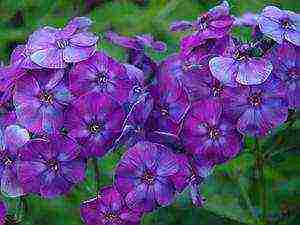 Variety "Alexander Immer" is distinguished by bright crimson flowers with a diameter of 3.5 cm, which are collected in a flat, loose inflorescence. Blooms in the twenties of June and blooms for 29-35 days.
Variety "Alexander Immer" is distinguished by bright crimson flowers with a diameter of 3.5 cm, which are collected in a flat, loose inflorescence. Blooms in the twenties of June and blooms for 29-35 days. - Phlox "Henry Gertz" bloom in early July with white flowers with a lilac-pink tint. The erect stems of the plant grow up to 50-55 cm. The loose pyramidal inflorescence measures 15x12 cm. It blooms within 30-35 days.
- Variety "Iris" is a bush up to 45-50 cm high. On a loose pyramidal inflorescence there are flowers with an uneven violet-lilac color and a carmine eye. It begins to bloom in early July and blooms for 29-35 days.
- Elizabeth Kambel is a medium-sized, upright shrub. Quite dense inflorescences grow up to 16 cm.The petals are salmon-pink in color, and the center of the flower is white. Blooms all July. Suitable for group planting and cutting.
Medium time plants
This type includes phlox, blooming in the second decade of July:
-
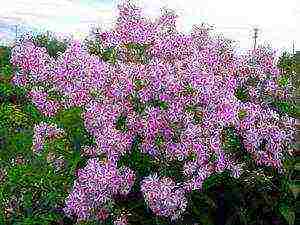 Variety "Le Madi" is distinguished by erect stems up to 40-50 cm high. From mid-July, it begins to bloom with dark violet-blue flowers with a carmine eye. The size of a rounded inflorescence reaches 11 cm. The duration of flowering is 25-38 days.
Variety "Le Madi" is distinguished by erect stems up to 40-50 cm high. From mid-July, it begins to bloom with dark violet-blue flowers with a carmine eye. The size of a rounded inflorescence reaches 11 cm. The duration of flowering is 25-38 days. - Variety "Mayak" is a tall bush 80 cm tall. On its dense pyramidal inflorescence, bright crimson flowers with a lighter center bloom. Blooms from mid-July for 30-35 days.
- The Fiery Bird variety grows up to 60-65 cm. Its dense pyramidal inflorescence measures 17x12 cm. The flowers are fiery red with a carmine eye that bloom from July 17-19 and bloom for more than 30 days.
- Variety "Othello" is distinguished by flowers, which are dark purple during the day and blue in the evening. Each flower has a diameter of 3.5 cm and is located on an oval, loose inflorescence. Blooms from mid-July to mid-August. The height of the bush can reach 80-90 cm.
- The Snegurochka variety is a tall bushes with erect stems up to 80-90 cm high. On a dense pyramidal inflorescence there are white flowers with a diameter of 3.7 cm. It blooms in mid-July and blooms for 30-35 days.
- The Apple Blossom variety is a medium-sized bush with pale pink flowers up to 4 cm in diameter. Blooms for about 40 days from mid-July.
- Variety "Schneeberg" is distinguished by branched, erect stems, the height of which can be up to 75-80 cm. Loose pyramidal inflorescences grow up to 20 cm and consist of white flowers 3.2 cm in diameter. It is overgrown with a large number of simultaneously flowering shoots.
- The variety "Ernst Immer" is a bush 60-65 cm in size. On a round, dense inflorescence there are white flowers with a pink ring in the center. It blooms for 30 days from mid-July.
Late flowering paniculate phlox
This group of plants blooms in August and even in September:
-
 The Lilac Late variety begins to bloom in early September. On its rather dense inflorescence there are lilac-pink flowers, the diameter of which reaches 3.8 cm.The erect stems are very high - up to 110 cm.The flowering period is about 40 days.
The Lilac Late variety begins to bloom in early September. On its rather dense inflorescence there are lilac-pink flowers, the diameter of which reaches 3.8 cm.The erect stems are very high - up to 110 cm.The flowering period is about 40 days. - The variety "Pink hydrangea" is a small bush up to 55-60 cm high. Its light pink flowers with a carmine eye form a dense, oval inflorescence up to 16x12 cm in size. It begins to bloom in late July and blooms for 20-30 days.
- Variety "Ostankino" is a tall bush 85-90 cm high. Dense, pyramidal stems are located both on the central bush and on the side shoots at the same time. In early August, it blooms with crimson flowers 4 cm in diameter. Flowering continues until September.
- Variety "Frau Antoine Buchner" is distinguished by erect stems that grow up to 100-120 cm. White flowers with a faint pink-lilac shade grow on a wide loose inflorescence. Blooms from mid-August until frost. Suitable for group planting and cutting.
- Variety "Shkolnik" is a bush up to 70 cm high. Its dense inflorescences consist of light purple flowers, which seem bluish at a great distance. It begins to bloom at the end of July.
- Variety "Yunost" is a tall plant, the height of the stems of which reaches 80-85 cm. Its pink-lilac flowers 4.2 cm in diameter are collected in an oval, loose inflorescence. Begins to bloom in early August, bears fruit.
Ground cover perennial phlox - photo
Creeping phlox species bloom in May. Their positive characteristics include small height up to 20 cm, drought tolerance and fairly easy reproduction.
Among gardeners, the following varieties of ground cover phlox are most popular:
-
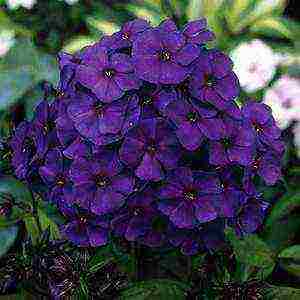 Forked phlox is a plant with pubescent stems and hard leaves. The flower petals are dissected, which gives the impression that there are twice as many flowers on the inflorescence. The color can be from blue to white.
Forked phlox is a plant with pubescent stems and hard leaves. The flower petals are dissected, which gives the impression that there are twice as many flowers on the inflorescence. The color can be from blue to white. - The Douglas variety is only about 10 cm high. It blooms for the first time in May, and then at the end of August. Differs in a dense pad of tough stems and flowers of various colors. Their color can be from white or lilac to purple.
- The subulate phlox resembles moss in appearance and is very popular among gardeners.
- Snow phlox differs in flowers from pink to orange in color. It is a very compact and winter hardy variety.
Loose phlox - photo
Loose phlox bloom right after the ground cover. These are forest plants that are resistant to temperature changes and abundant flowering. The most famous varieties:
- The splayed phlox is a shrub with delicate and lush blue or white flowers that look like a cloud during flowering. The plant grows well on any drained soil.
- The variety "Adsurgens" is distinguished by its large flowers, so it looks very elegant during flowering. Loves well-drained, nutritious soils.
- The "Pressed" variety is a 30 cm tall bush that blooms with pink flowers. Grows well on loose, nutritious soils.
Stoliferous phlox - photo
These are unpretentious plants that, thanks to the stolons rooting in the nodes, develop very quickly. They have a thick rhizome, and their stems grow so that even weeds do not germinate through them. They take root literally from one contact with the ground. As a result, new peduncles grow, and dense, beautiful carpet... They should be planted in fertile, moist soils and shady areas.
The most popular varieties are:
- The Blue Ridge variety grows up to 25 cm and blooms with purple-blue flowers with a yellow stamen. Prefers to grow in loose soil and semi-shady areas. Loves abundant watering.
- Variety "Purpurea" grows well in partial shade. Its peduncles reach 25 cm in length and consist of pale pink flowers with yellow stamens.
- Fuller's White is a flexible, creeping plant with a height of about 30 cm. It blooms for a long time with white flowers without any extraneous impurities and shades. Suitable for the formation of an alpine slide and wall decoration. Suitable for cutting.
- Violet Queen grows up to 40 cm and blooms with blue flowers with a lilac hue. Flowering lasts no more than thirty days, after which the peduncles are cut off. Suitable for cutting.
Phlox in landscape design - photo examples
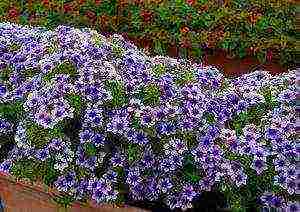 Perennial flowers will look great both in single plantings and in composition with other plants. With the help of some paniculate varieties, you can mask a fence, a barrel, wall errors, old curbs on the site. They you can divide the garden into zones.
Perennial flowers will look great both in single plantings and in composition with other plants. With the help of some paniculate varieties, you can mask a fence, a barrel, wall errors, old curbs on the site. They you can divide the garden into zones.
Alpine slides, flower beds, lawns, garden paths are decorated with subulate phloxes. A brightly colored carpet can be grown from groundcover varieties instead of lawn grass.
Phlox will look good with other colors. Them neighbors can be roses, daylilies or silvery ephedra. Bright roses will look very impressive against the background of pale white phlox. An interesting "carpet" can be created from a group of plants of the same color, but in different shades.
Despite the simplicity of the buds and the uncomplicated lines, with the help of phlox you can wonderfully decorate a summer cottage, garden, front garden or balcony. And among the variety of species, even the most fastidious florist will find a variety to his liking.
Perennial phlox
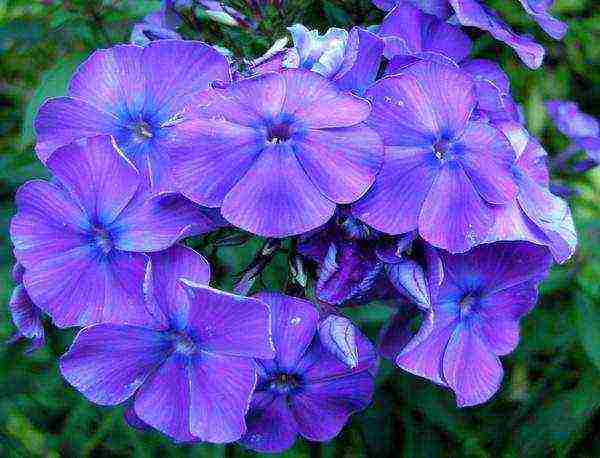 Charming phlox
Charming phlox
In the garden, each gardener has his own flowers, but there are those types that almost everyone loves. Let's take phlox - fragrant, delicate, so different and pleasing to the frost flowers, well, who can not love them. If you don't have these nice bushes in your flower beds yet, then it's time to fix the situation. Today we will tell you about a species that includes many varieties for every taste - this is paniculate phlox. It will become a worthy decoration for your garden, but read about the growing method and more.
Flaming Flowers - Inspiration for Legend Makers 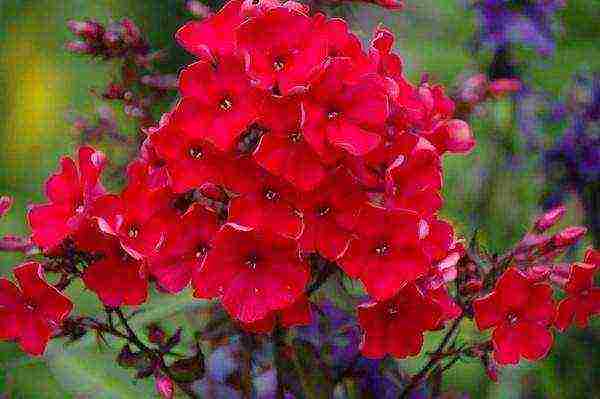 Flowers associated with fire
Flowers associated with fire
You know that phlox in Greek means flame. Endowed with a beautiful name by none other than Karl Liney. And now people argue why this is how phlox were named - perhaps because there are varieties of rich red tones, and when they all bloom like a carpet on the field, it seems that it is engulfed in fire. We think that the flowers could have received such a name due to the fact that many of them have pointed petals, like a star.
Well, what about the legend? There it is - at a time when people and gods lived together, Odysseus and his companions were forced to visit the afterlife, where Hades ruled. To illuminate the path, Odysseus carried torches, but when the mission was completed, and he returned to earth, he threw them away. Where torches fell, unusual flowers grew, and as you can understand, according to the legend, these were phloxes.
On a note! There is another opinion about the origin of the name of flowers, but not so common. It is believed that phlox was named so in Germany, they have the word "flocken", translated into our language - it is snow flakes.
Description of paniculate phlox 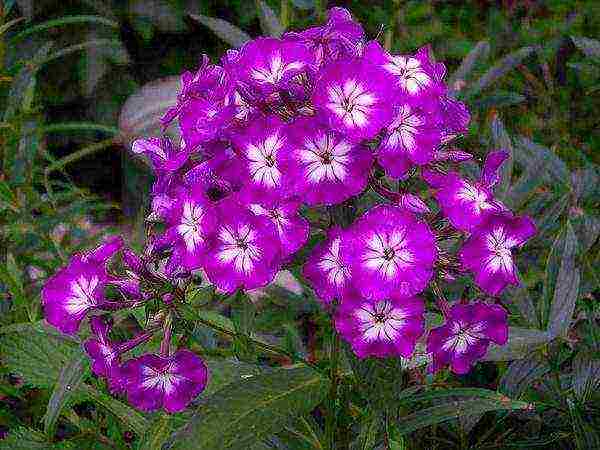 Flowers are very varied
Flowers are very varied
Paniculate flowers are called panicle-shaped inflorescences. Beginners may not know this, and not only phlox are like this, but other plants as well. For example, the luxurious hydrangea, which is often found in our gardens. Phlox have many different species, which already include their own varieties.
Legends are legends, but now scientists are more inclined to believe that phlox are originally inhabitants of North American content. Because the most different species were found there. As for the European and Asian countries, only one of the wild phloxes can be found there - the Siberian species. Moreover, this is not at all the flower that we are used to seeing in the garden, no - it is a small ground cover bush.
For information! Phloxes are very different, there are more than 70 perennial species, there are even more varieties, but there is only one annual species - undersized "Drummond".
Phlox paniculata can grow throughout our country. Its flowering begins in the third decade of June and ends when a severe frost hits. Also, flowers are called garden flowers, they are perennials. Bushes, depending on the variety, can be from 40 to 150 cm, they are of incredible colors, while the shape of the panicle can be different. The root system is mainly located near the soil surface - 5-20 cm, very powerful.
Advice! When planting perennial flowers with strong roots, immediately determine where it will be best for them, how it is more profitable to decorate the landscape with them, since it is not easy to transplant such plants.
Phlox paniculate rather large bushes, often spreading, they need a lot of space. Also, a powerful root system needs regular nutrition and hydration. If these two methods of agricultural technology are observed, then flowering will be more abundant and will continue until the most severe cold weather. The seeds ripen in late autumn, after which the stems begin to die off. They can be cut in the winter, but in the spring the bushes will revive again. The roots tend to rise annually, since new buds are formed higher than the previous ones, so sometimes you have to add nutrient soil.
On a note! The color scheme of paniculate phlox is luxurious, incredibly diverse - there are innocent white, scarlet, purple, and stormy sky colors. But yellow shades among perennials are practically not found.
Phlox paniculata - getting to know the varieties and their photos
"Albatross"
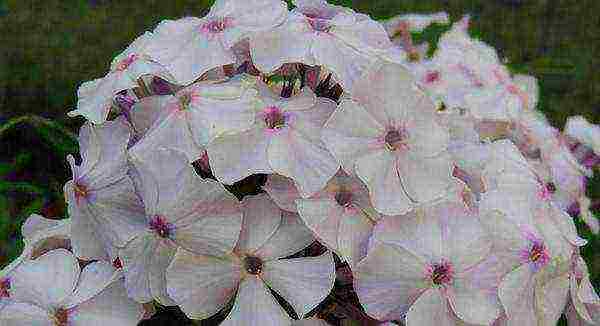 Delicate charm
Delicate charm
Large-flowered variety - up to 4 cm. The shade can be white or heavenly; in dry years, summer residents noted the appearance of an asterisk in the center. It perfectly tolerates severe winters, is not afraid of diseases. The panicle is not very densely packed with flowers, spreads out to the sides slightly, there are few leaves on the stems. It has an average flowering period, the height of the bushes is 50-55 cm. It is an unpretentious variety and reproduces very well.
"Alexander Immer"
 Modest and pleasant
Modest and pleasant
These phloxes are paniculate with a pleasant raspberry shade, 3-3.5 cm in diameter. The shade of inflorescences is uniform, does not fade throughout the entire period. Phloxes are flat spherical, loose, not very bulky. The bushes are slightly less than half a meter in height. Not afraid of diseases, winters well.
"Butonik"
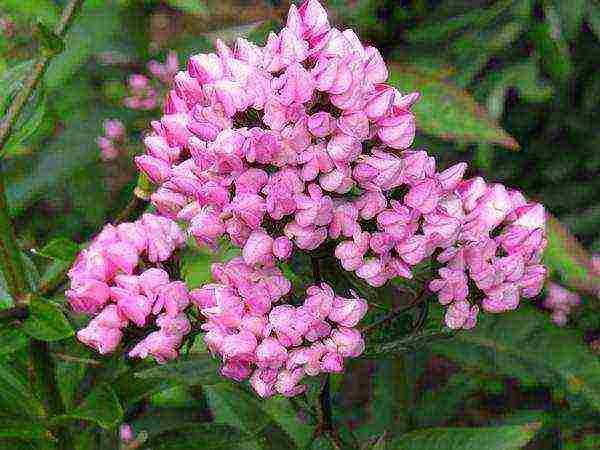 Original cones
Original cones
An interesting variety, as its panicles are densely packed with flowers that do not fully open. As a result, some of the flowers remain in the shape of a cone of petals - they look unusual and decorative.The height can vary from 50-70 cm, while the bushes themselves do not fall apart. It has an average flowering period, rapid growth, high winter hardiness. The shade of flowers is pink-lilac.
Advice! Phlox can be very beautifully combined. For example, planting tall white varieties along the fence in the background, and undersized purple or red varieties in the foreground. Very aesthetically pleasing.
"Bouquet"
 Delicate and romantic
Delicate and romantic
Large-flowered - up to 4.5 cm in diameter, the shade of the petals is pale pink. All season the colors do not change, the inflorescence has a slight texture. The shape is conical and round. The panicle is large, well-stuffed, very decorative. The height of the bush is from 60 to 70 cm, there is a slight pubescence on the stems, does not disintegrate, the leaves look down. Highly resistant to diseases, cold.
"Waltz"
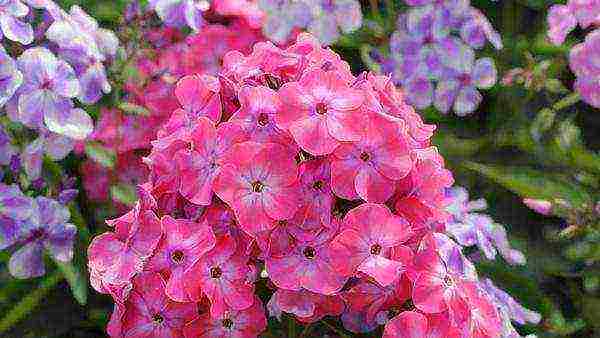 Luxurious shade
Luxurious shade
This variety of paniculate phlox has a delicate shade of salmon; it is slightly lighter in the middle. The inflorescence is hemispherical, it can change its shade in the hot sun - burn out, which is not very good. The height of the bushes is up to 70 cm, they look impressive, the stems are closely spaced to each other. Flowers - up to 4 cm in diameter, the edging has a wave. It easily tolerates a harsh winter, dry summers, but has an average resistance to diseases.
"Gilyay"
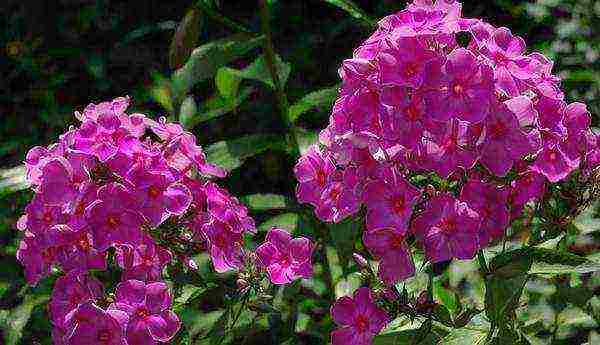 Common phlox
Common phlox
The variety has a lilac shade of inflorescence, it is large, well-stuffed. The bushes grow compactly, although they are tall - up to 75 cm. It has an average flowering period, it tolerates cold well, and is not afraid of attacks by fungal diseases. This panicled phlox can often be found in the flower beds of our summer residents.
"Dove of peace"
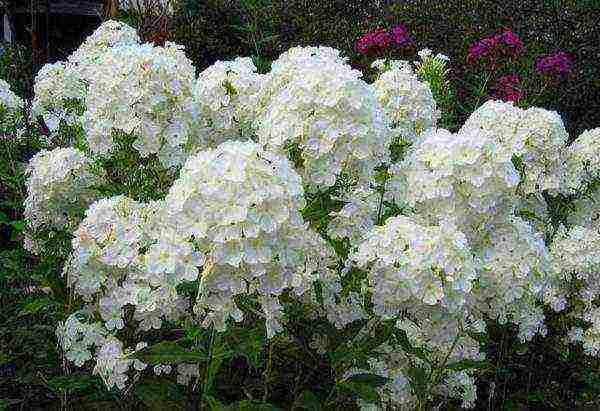 White grace
White grace
White phlox, up to 4 cm in diameter, large pyramid-shaped inflorescence. The bushes are very impressive - up to a meter in height, they have a lot of leaves, the variety grows quickly, does not decay. Very unpretentious flowers, they are not afraid of all adversity, they look luxurious, especially in combination with 1-2 more shades.
Advice! When choosing varieties for your summer cottage, consider the shades so that they are either combined with each other, or there are 2-3 of them. Otherwise, the flower bed looks catchy and lurid, the beauty of individual flowers is difficult to discern.
"Blue joy"
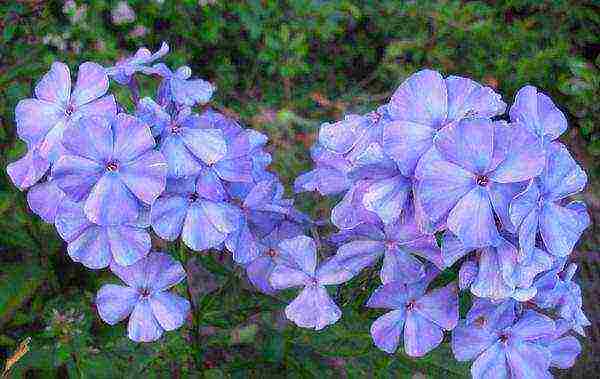 The lavender shade is especially luxurious
The lavender shade is especially luxurious
It has a blue tint, but there are also notes of purple, the middle of the flower is darker. The bushes grow up to a meter or more, are medium-sized, and have the shape of a cone. Flowering - medium late, highly resistant phlox to diseases and bad weather. There is pubescence on the stems. The hue may vary depending on the lighting conditions.
"Mishenka"
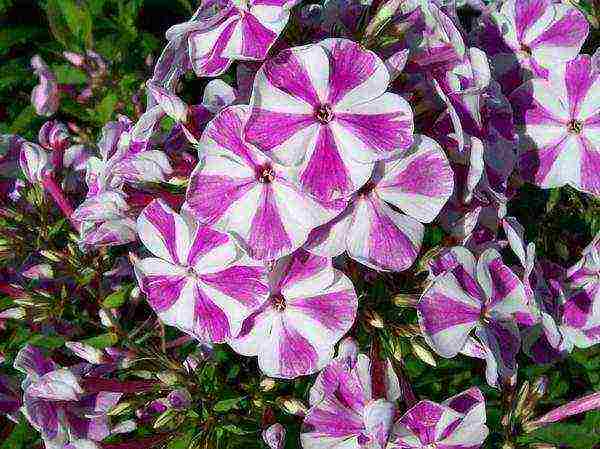 Flowers for a great mood
Flowers for a great mood
This variety of paniculate phlox has a beautiful petal color - white with a scarlet stripe. But all summer this shade does not persist, it can brighten, fade. The diameter is up to 3.5 cm, the shape of the inflorescences is in the form of a pyramid. The bushes are high - up to 1 meter. It has an average flowering period, reproduces well and does not require special care, does not freeze out.
"The Dragon"
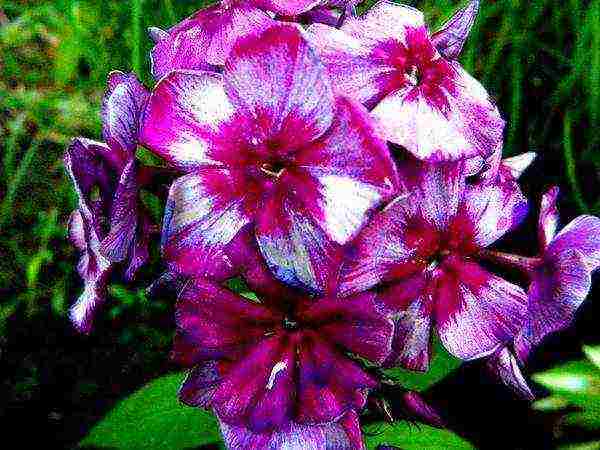 Extravagant variety
Extravagant variety
A very beautiful and unusual variety. It changes the hue of the petals from deep purple to silvery. In the middle is a purple-red star. Height - up to 90 cm, average flowering time, like all previous varieties, does not get sick and is not afraid of frost.
Zhukovsky
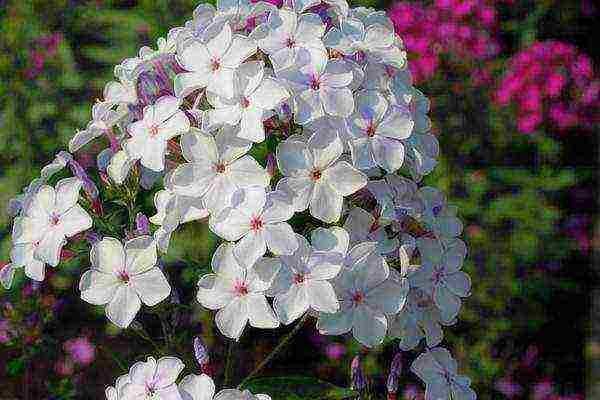 Persistent and beautiful
Persistent and beautiful
This variety of paniculate phlox is somewhat similar to hyacinths, as many summer residents believe. Inflorescences are conical, large, loosely packed. In diameter - up to 3.5 cm. Tall - up to 1 meter. It can be thrown to the side, it is considered the most hardy variety of phlox. The shade adorns the flower beds - it is white with undertones of blue, lilac.
Sunshine
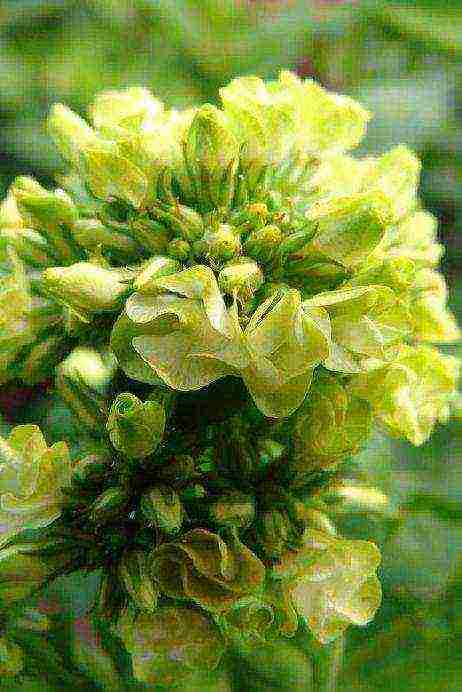 Unique shade
Unique shade
Phlox paniculata of this variety will win the heart of any gardener. This is just the case when the shade can be called yellow, although it is still more light green. The height of the bushes is up to 90 cm, the diameter of the flowers is small - up to 1.5 cm, but they are densely packed on a panicle, they look very decorative, as you can see for yourself in the photo. Decorate both a flower bed and a vase.
"Igor Talkov"
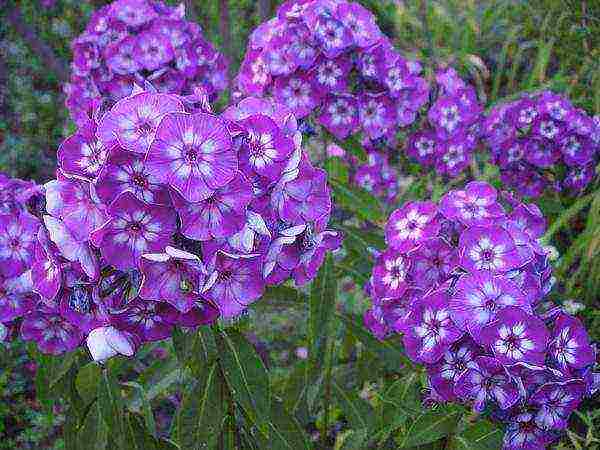 Unpretentious and pleasant
Unpretentious and pleasant
The variety has very large flowers - up to 5 cm in diameter, they are deep purple, white in the center. Phloxes do not lose their color all season. Inflorescences are dense, hemispherical, well-stuffed. The bushes grow up to 80 cm, have an average flowering period, do not decay. It is not afraid of diseases and severe frosts, it grows quickly.
"Favorite of Gaganov"
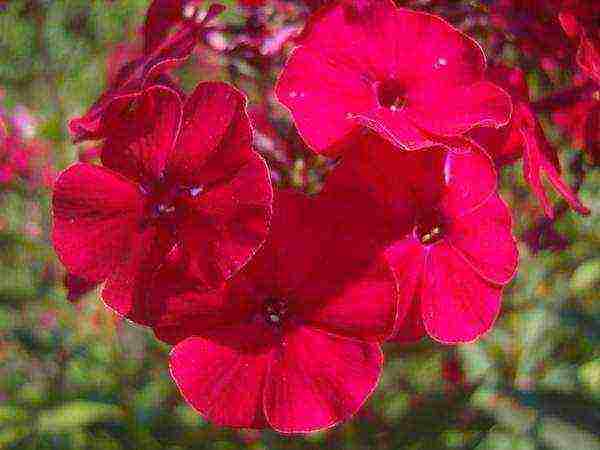 Scarlet velvet
Scarlet velvet
A stunning variety with scarlet velvet petals. They are up to 3.7 cm in diameter, the color of the phlox does not lose all summer, after the showers, the petals still remain decorative, spots do not appear on them. The inflorescence is spherical, full of flowers, large. These bushes are relatively low - 40-50 cm, do not decay. Flowering - medium late, phloxes do not get sick and winter well.
"Old lighthouse"
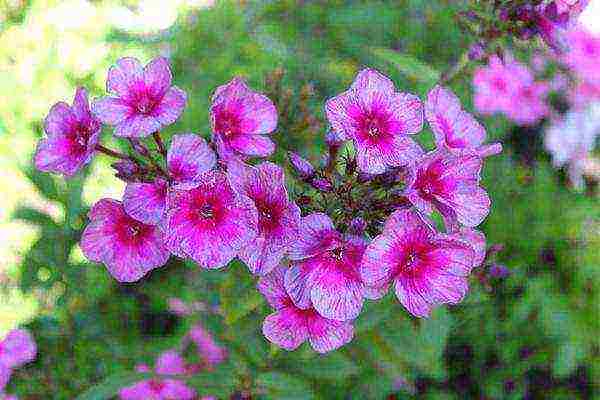 Excellent flowers for a bouquet
Excellent flowers for a bouquet
This paniculata phlox is very pleasant and pleasing to the eye. Its petals are lilac at the edges, and a pink star adorns the middle. It grows - up to 75 cm, grows medium, winters well. Inflorescence - conical, densely packed, flower diameter - up to 4 cm. Flowering - medium early. Bushes do not decay.
We are representatives of 15 very good varieties, we have chosen those that can winter even in our climate, when drought is replaced by rainstorms, and thaws are replaced by severe frosts. The flowers are quite resistant to cold weather, as well as to many ailments, but they need moisture and nutrition. But this is already another section, where we will talk about planting and caring for the paniculate phlox species.
Advice! Varietal flowers in the season are not so easy to buy, so it is better to go to the shops with seeds in advance or order online. But always pay attention to the packing date.
Agrotechnology for growing paniculate phlox - all point by point from the very beginning
We will tell you how to grow beautiful flowers from the first stage - seedlings. Paniculate phloxes can reproduce easily - by layering, dividing the bush and rhizomes. You can separate flowers in early spring and autumn. Of course, any plant is grown from seeds, but it is worth noting that in phlox they quickly lose their germination. Well, we are starting to sow.
Preparation of soil, containers and seeds
 The cold hardens the seeds
The cold hardens the seeds
Everything is simple here - the trays must fit your windowsill. You can immediately sow paniculate phloxes in separate peat pots, which are then planted immediately in the ground on the street. The seeds must first be kept cold for a week - stratification by placing them in the refrigerator. The soil is suitable for the store or soil from the garden, mixed with humus, sand, ash. The first two components can be taken 1/1, the last - 1/3.
Advice! To prevent fragile seedlings from getting sick, pour the soil under the seedlings with boiling water with manganese crystals.
Timing and landing
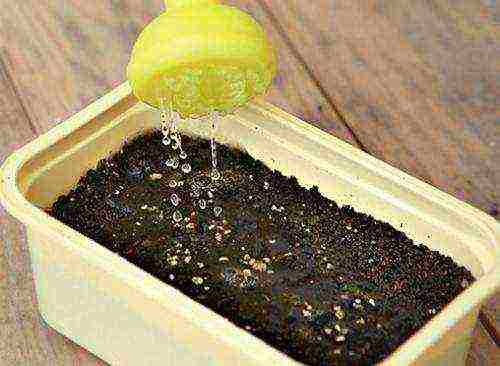 Better not to water the crops from a watering can
Better not to water the crops from a watering can
Sowing can be done from the second decade of March to April. Transfer to open ground will be after all frosts have passed. Yes, you can say, they say, paniculate phlox are frost-resistant, we said it ourselves. That's right, but we are talking about adult plants. So, if you are already warm in early May, then sowing can be done even earlier, if closer to mid-June, then wait until April so that the seedlings do not outgrow.
Sowings are carried out in rows up to 1 cm deep at a distance of 3-5 cm, after which they are lightly sprinkled with soil. Moistened from a spray bottle so as not to wash off crops. Then cover with a film until germination. The room should be warm - 20-23 degrees. Under such conditions, the seedlings will sprout in about a week and a half, immediately the film must be removed and the containers placed on a sunny window.
If you have sown densely, then in the phase of 3-4 true leaves you need to thin out the seedlings, leaving the strongest seedlings. About a week after transplanting, when the seedlings have already adapted, you need to add nitrogen fertilizer, which can be found in any gardening store or with flowers.This will give strength to the seedlings, and they will begin to build up green mass well. Two weeks before planting outdoors, the seedlings are hardened, lowering the temperature.
Important! If you decide to leave the seedlings outside overnight, considering that they are already quite strong, then follow the forecast so that there are no frosts. Even just hypothermia leads to a slowdown in growth and development.
Landing in a permanent place
 For a flower bed, choose no more than three shades
For a flower bed, choose no more than three shades
In May, a week before planting, the site needs to be prepared - all weeds, roots, and crop residues are removed. Then you need to dig up the ground. Paniculate phloxes like to have enough moisture and air in the soil. Therefore, if your soil is too heavy, then add 1-2 buckets of sand per square meter. If the soil is acidic, sprinkle 100-200 grams of lime. If, on the contrary, the area is too sandy, then the soil is mixed with compost and, if possible, add a little clay. Loam is diluted with a glass of wood ash, 50 grams of superphosphate, a bucket of humus, 100 grams of bone meal.
So, all fertilizers are applied per square meter, then, with them, the site is dug up and spilled with boiling water with manganese. When the earth dries up, holes are made. Depending on the size of the seedlings, they can be small - for seedlings or the size for the rhizome, which should be free inside. If during the digging you did not apply any fertilizers, now you can fill the hole a third with humus or rotted compost and add a little less than a tablespoon of a complex mineral preparation. Then paniculate phlox are planted, covered with soil and spilled abundantly.
Advice! So that the soil retains moisture well, does not overheat and keeps warm in cold weather, the flowers are mulched. For the summer, it can be decorative materials, for the winter, simple straw, peat or spruce branches.
Care after landing
 You need to feed 4-5 times per season.
You need to feed 4-5 times per season.
Two weeks after planting, when the seedlings are rooted, nitrogen fertilization can be applied. You can feed with saltpeter - a spoon in a bucket of water or manure - 1/10 with water, the mullein is also bred in the same proportion. Then, every 14-20 days, paniculate phlox will need to be fertilized in turn with mineral compounds and organic matter. For example, it can be 10 grams of potassium and the same amount of superphosphate mixed with wood ash, you can take the drug "AVA". Organic chicken manure is used - 1/20 with water. An approximate schedule should be as follows - after picking, after rooting, during budding, flowering and after it ends.
Advice! If you don’t have time to breed different fertilizers with water, then just buy any liquid preparation at a flowering plant store.
As for other agricultural techniques, paniculate phloxes require a minimum of attention. Watering should be done as the soil dries, the soil should be loosened carefully so as not to damage the roots. Of course, weeds will be regularly removed from the beds, and those bushes that disintegrate to the side need to be tied up.
How to propagate phlox? 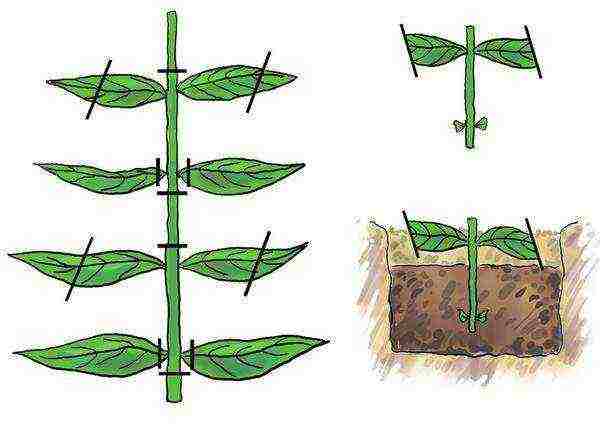 Propagation method by part of the stem
Propagation method by part of the stem
About seed reproduction, we told you how to get seedlings too. But what if you want to separate your phloxes, which have already grown? It couldn't be easier. This can be done in early spring or autumn, when the aerial part has not yet grown, by dividing the root into parts. Or, separate the part completely from the bush, but not during flowering, so that phloxes do not start to hurt. Then you prepare the holes again, fertilize and plant flowers. The first 1-2 weeks you need to cast the bushes, and soon they will take root.
Diseases of paniculate phlox 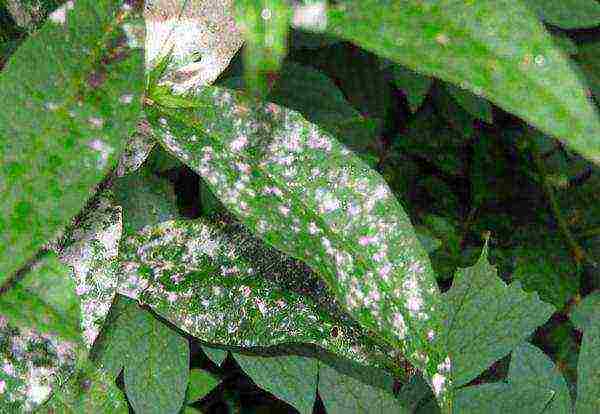 Powdery mildew
Powdery mildew
The flowers are unpretentious and they can only get sick with improper agricultural technology. If you are feeding, you have chosen a good sunny place, other high plantings do not interfere with the plants, there are no weeds, then phloxes will not hurt.If they lack something, then a number of ailments may develop:
- powdery mildew - quite common on phlox. It looks like a white coating of flour. For wrestling use "Oxyhom", "Hom", Bordeaux mixture, "Abiga-peak";
- phomosis - most often formed during budding, flowers begin to curl and wither. Bordeaux mixture and cutting off diseased parts will again help;
- rust - the leaves are covered with brown spots. For processing, copper sulfate and Bordeaux mixture are changed.
These agricultural techniques are enough to grow luxurious paniculate phlox. Taking care of flowers will help to avoid various negative moments, in return you will get a long beautiful flowering.
